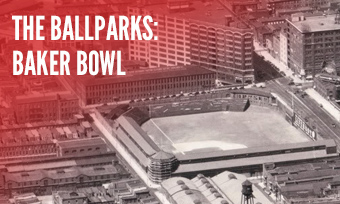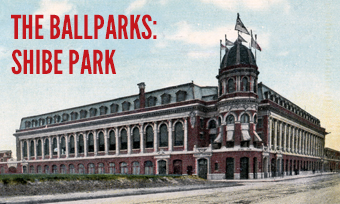THE TEAMS
Philadelphia Phillies
Known as the Philadelphia Quakers, 1883-89
THE PHILLIES BY THE DECADE
The 19th Century
The franchise that has lost more games than any other in major league history didn’t waste any time counting the defeats when it limped through an inaugural, eye-wincing 17-81-1 campaign in 1883. Baseball pioneer Harry Wright was brought in afterward and stabilized the fledgling unit, which evolved to placing second or third seven times—but never first—before the turn of the century. The Phillies of the 1890s were especially brutal on pitching, with Tuck Turner (.380 as a Phillie), speedster Billy Hamilton (.360), slugger Ed Delahanty (.348), and Sam Thompson (.334) as major contributors; all four hit over .400 on a particularly potent 1894 roster that averaged .350—the highest recorded in pre-modern times.
The 1900s
The Phillies were one of the teams hardest hit by player raids from the newborn American League and suffered for it through mid-decade before stabilizing as a .500 squad that seldom contended. That mild rebound was partially attributed to star hitter Sherry Magee, who went straight from unorganized ball to the majors at age 19. The 1900s were nearly overshadowed by a tragic 1903 incident when a crowded overhang behind Baker Bowl’s left-field bleachers gave way 20 feet onto a street during a game, killing 12 and injuring nearly 300.
The 1910s
Further improvement took place in Philadelphia with the arrival of legendary pitcher Pete Alexander—who won 30-plus games over three successive seasons from 1915-17—and by slugger Gavvy Cravath, whose 24 home runs in 1915 were unusually high for the deadball era and, briefly, a record in modern times before Babe Ruth redefined offense in the 1920s. The Phillies won their first-ever National League pennant in 1915 but were easily taken care of in the World Series by the Boston Red Sox.
The 1920s
Hard times set in as the Phillies, long having traded away Alexander, finished last in team earned run average every year during the decade—and placed last in general six times, their top mark a mediocre 71-82, fifth-place record in 1929. Excitement was to be found on offense, as Cy Williams became the first National Leaguer (in 1923) to hit 40 homers in a season.
The 1930s
The Phillies’ offense continued to provide a solid punch, but their pitching took a worse beating and the team’s struggles in the standings continued, finishing last or next-to-last eight times while managing their only winning season over a 32-year span in 1932. The height of the Phillies’ outrageous imbalance of power and pitching came in 1930, when they hit .315—but lost 102 games because opponents hit .349 against them. The bandboxed Baker Bowl, the primary reason for the upswing in offense, was abandoned by the Phillies in 1938 in favor of Shibe Park, home of the A’s.
The 1940s
The franchise hit its low point in the early 1940s when bankruptcy was declared and the alleged savior, new owner William Cox, butted heads with and fired manager Bucky Harris—nearly leading to a team revolt—before being ousted from baseball after one year for admitting he had bet on Phillies games. Cox’s successor, Robert Carpenter, built up a more respectable front office (but also made a half-hearted attempt to rename the team the Blue Jays, which failed to hold), and the team slowly began to improve on the field as a result.
The 1950s
The momentum of the late 1940s peaked in 1950 when the youthful “Whiz Kids” Phillies won the franchise’s first pennant in 35 years, only to be swept in the World Series by the New York Yankees. From there, the Phillies began a gradual slow regression back towards the second division late in the decade, despite the efforts of prodigious ace pitcher Robin Roberts (who won 138 games from 1950-55), RBI machine Del Ennis and superb center fielder Richie Ashburn.
The 1960s
Devolved into a gruff and undisciplined unit, the Phillies were remolded by tough young manager Gene Mauch—but not before enduring his own baptism in 1961 when the Phillies hit rock bottom with a 47-107 record that included a modern record 23-game losing streak. Just three years later, a NL pennant looked all but locked up for the Phillies, leading by 6.5 games with 12 to play—before a historic collapse scuttled their chances. Again, a brief flirtation at the top was followed by gradual decline for the rest of the decade.
The 1970s
The Phillies sank further into the abyss to start the decade but emerged once more as a contender—this time for the long run—at new multi-purpose Veterans Stadium with a fresh generation of star talent including slugging third baseman Mike Schmidt, lumbering outfielder Greg Luzinski and stellar, quirky left-handed ace Steve Carlton. They won 100 games for the first time ever in 1976, won another 100 the next year and made three straight NLCS appearances—losing each time.
The 1980s
After nearly 100 years in business, the Phillies finally won a world title in 1980 as they barely outlasted Houston in the NLCS and took down Kansas City in six games at the World Series. Philadelphia would return to the Fall Classic in 1983 with a cast of aging veterans named the “Wheeze Kids,” but lost to Baltimore in five games. Schmidt won three MVP titles during a decade in which notoriously tough Phillies fans inexplicably continued to ride him; as age wore him down late in the decade, the team also suffered as no one was ready to take his mantle.
The 1990s
The Phillies would finish above the .500 mark only once in the 1990s, but they made it worth their while—with a raucous roster soaring to a NL East title and an upset NLCS victory over powerhouse Atlanta, before succumbing to Toronto’s heroics in a six-game World Series. Despite the emergence of Curt Schilling as a 300-strikeout ace and, later in the decade, the arrival of Scott Rolen and Bobby Abreu, the Phillies struggled behind a lack of pitching depth.
The 2000s
With the help of a new ballpark (Citizens Bank Park) which frequently sold out, the Phillies were upgraded to one of baseball’s top teams with their longest string of winning seasons to date and a brilliant lineup that included the powerful Ryan Howard, gifted middle infielders Jimmy Rollins and Chase Utley and an emerging rotation fronted by Cole Hamels. The Phillies won back-to-back pennants in 2008-09, winning it all over Tampa Bay in 2008.
The 2010s
The Phillies continued their reign into the 2010s as Roy Halladay and Cliff Lee beefed up the rotation and helped run the team’s streak of divisional titles to five. But chronic injuries to aging veterans, mixed with an inability to effectively reload with young talent, brought the Phillies crashing back below .500—and into rebuild mode. A bulking up of star talent at decade’s end—most notably with a record contract given to Bryce Harper—portends better times ahead.
The 2020s
Under the guidance of veteran exec Dave Dombrowski—who oversaw success at Florida, Detroit and Boston—the Phillies initially underperformed with a healthy star-spackled lineup that couldn’t muster much more than a .500 record. But in 2022, they modestly upped their win total and snuck into an expanded postseason as the low #6 seed—and nearly ran the playoff table, stunning its way to an NL pennant before bowing to a superior Astros team at the World Series. They fell a game short of a second straight pennant one year later.
Highlights of the Phillies’ History on This Great Game:
 1930: The Big Blastcast of 1930 For better or (mostly) for worse, the Phillies are the poster children for a wild offensive frenzy in which the National League as a whole hits over .300.
1930: The Big Blastcast of 1930 For better or (mostly) for worse, the Phillies are the poster children for a wild offensive frenzy in which the National League as a whole hits over .300.
 1950: Gee Whiz! The Phillies overcome decades of futility and embarrassment with a rare National League pennant.
1950: Gee Whiz! The Phillies overcome decades of futility and embarrassment with a rare National League pennant.
 1964: The Fizz Kids How the Phillies, leading the National League by 6.5 games with 12 left to play, suffer through baseball’s most infamous pennant race collapse.
1964: The Fizz Kids How the Phillies, leading the National League by 6.5 games with 12 left to play, suffer through baseball’s most infamous pennant race collapse.
 1980: Finally Philly Hank Aaron ascends to the superstar elite and gives Milwaukee its first World Series title.
1980: Finally Philly Hank Aaron ascends to the superstar elite and gives Milwaukee its first World Series title.
 1983: The Good, the Old and the Ugly The Baltimore Orioles victoriously wind their way through the postseason, ultimately upending the Phillies—baseball’s surprisingly good over-the-hill gang.
1983: The Good, the Old and the Ugly The Baltimore Orioles victoriously wind their way through the postseason, ultimately upending the Phillies—baseball’s surprisingly good over-the-hill gang.
 2008: Out of Darkness, Rays of Light Thought to be eternally chained to the bottom of the AL East standings, the Tampa Bay Rays become one of the game’s unlikeliest surprise teams with a stunning appearance in the World Series alongside the Phillies.
2008: Out of Darkness, Rays of Light Thought to be eternally chained to the bottom of the AL East standings, the Tampa Bay Rays become one of the game’s unlikeliest surprise teams with a stunning appearance in the World Series alongside the Phillies.





